#Sinhala Interpretation
Explore tagged Tumblr posts
Text
Exploring the Richness of Sinhala: Sinhalese Language of Sri Lanka
Unveiling the Captivating World of the Sinhala Language The Sinhalese language is a linguistic gem with deep roots in Sri Lanka’s vibrant culture and history. With its melodious tones and ancient origins, this Indo-Aryan language has fascinated linguists and culture enthusiasts alike. This article explores the fascinating intricacies of the Sinhala language, exploring its development, its…
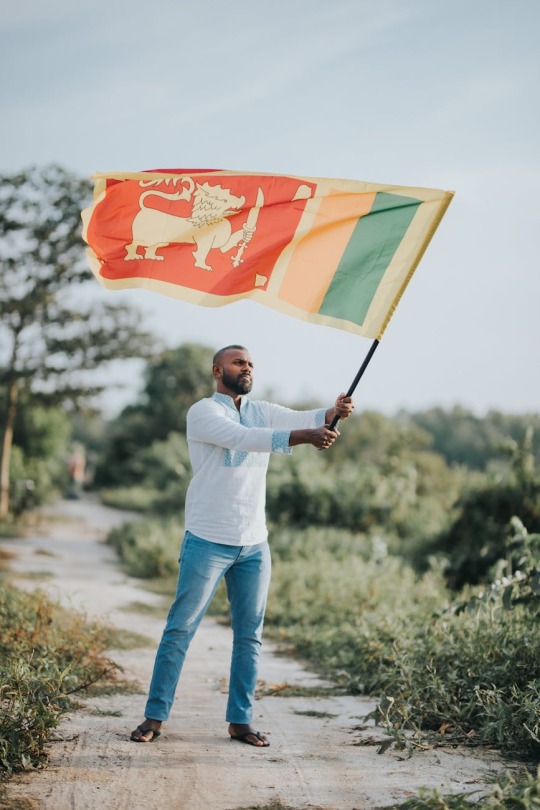
View On WordPress
#accessibility#Colloquial Sinhalese#Cultural Significance#Indo-Aryan Language#Language Access#Language Evolution#Language Services#Language Shift#LanguageXS#Linguistic Diversity#Literary Sinhala#Pali Influence#Sanskrit Influence#Sinhala Alphabet#Sinhala Interpretation#Sinhala Language#Sinhala Script#Sinhala Translation#Sinhalese Speakers#SOV Word Order#Sri Lanka Heritage#Sri Lankan Culture#Subject-Object-Verb#Syllabic Script#Vedda Language
0 notes
Text
An organiser of a "white party" in Sri Lanka has apologised after the event sparked a backlash online.
The event's advertisement specified a white dress code, but also had a line saying "Face control: White" - which was largely interpreted to mean the event was open only to white people.
An organiser later said the event was "a bad idea", adding that it was meant to bring together expatriates.
The party, which was due to take place last Saturday, was cancelled.
Backlash against the event was swift, with many on social media calling it "disgusting" and "racist".
"I know not all expats are like this... but this sort of thing should be stopped fast and stopped hard," said one local restaurant owner.
"How dare they come to a brown country and ban the people of that country," another social media user said on Facebook.
Writing on Instagram under the handle geo_ecstatic, a man who said he was an event organiser, said there was "no malice or racism" in planning the party.
"We wanted to meet expats who have been living here for a long time and love Sri Lanka. The team... supported me and a joint decision was made to quickly organise a party," he said, adding that he has since had to leave the country after receiving a barrage of abuse and threats.
"I didn't expect this to be such a sensitive moment for a huge number of people. I admit that it was a bad idea... and I understand that we created it ourselves out of our stupidity. I deeply apologise to everyone whose feelings were hurt."
The event was due to be held in the Sarayka Lounge in the southern coastal town of Unawatuna. The venue later posted a statement saying the party had been cancelled, adding that its staff team " did not conduct a thorough-enough check" and have "severed ties" with the event planners.
"We have never supported and will never support various racist statements or organisations," they wrote.
The organiser as well as the owners of Sarayka Lounge are believed to be Russian citizens.
Rupasena Koswatta, president of an Unawatuna entrepreneurs' association told BBC Sinhala many Russians have moved into Unawatuna, a coastal city just 5km (3.1mi) from Galle, in the last two years.
Many of the tourism businesses there are now owned by Russians in the area now known by many as "Little Moscow".
The Russian Embassy in Colombo later released a statement saying it "strongly condemns all forms of racial discrimination and nationalism" and urged citizens residing on the island to follow its laws and respect local customs.
Later on Sunday, Sri Lanka said it had ended long-term tourist visa extensions for Russians and Ukrainians. More than 288,000 Russians and nearly 20,000 Ukrainians have travelled to Sri Lanka since Moscow's invasion of Ukraine, according to reports. But the country's President Ranil Wickremesinghe later reportedly said the decision was made without prior Cabinet approval.
3 notes
·
View notes
Text
Sarigama: A Sinhala Adaptation of The Sound of Music
Sarigama is a Sinhala musical film released in 2016. It's a captivating adaptation of the iconic Hollywood classic, The Sound of Music. The film successfully captures the essence of the original story while infusing it with Sri Lankan culture and music.

Key Details:
Directed by: Somaratne Dissanayake

Produced by: Renuka Balasooriya
Starring: Pooja Umashankar, Ashan Dias, Malini Fonseka, Gayani Gisantika




Release Date: December 2, 2016
Plot: The film follows the story of Maria, a young and spirited woman who becomes a governess to the seven children of a widowed ex-navy captain. Her love for music and her playful nature transform the lives of the family.
Notable Aspects:
Local Adaptation: The film effectively adapts the original story to fit the Sri Lankan context, showcasing local culture and traditions.
Musical Brilliance: Sarigama boasts a beautiful soundtrack with original Sinhala songs that complement the narrative.
Stellar Performances: The cast delivers commendable performances, particularly Pooja Umashankar and Ashan Dias in the lead roles.
Visual Appeal: The film's cinematography captures the beauty of Sri Lanka, enhancing the overall viewing experience.

** This movie is a cinematic interpretation of the 1965 Academy Award-winning musical Sound of Music, which drew inspiration from Maria Von Trapp's 1949 autobiography. Adjustments were implemented to better fit the regional context, steering clear of political themes entirely; the movie concludes with the union of Maria and the Captain. Filming took place in scenic hill country locations, showcasing the island's natural beauty.
Differences Between "The Sound of Music" and "Sarigama"


Cultural Adaptation:
Setting: The original is set in Austria, while "Sarigama" is set in Sri Lanka, showcasing the country's beautiful landscapes and cultural elements.
Costume and Design: The costumes and set designs are adapted to reflect Sri Lankan fashion and architecture.
Lifestyle: The film incorporates Sri Lankan customs, traditions, and daily life into the storyline.
Storyline Adjustments:
Character Development: While the core characters remain similar, there might be subtle differences in their personalities and backstories to align with Sri Lankan societal norms.
Plot Twists: To accommodate the new setting, some plot elements might be adjusted or added to fit the Sri Lankan context.
Conflict and Resolution: The challenges faced by the characters might be different due to the unique social and political climate of Sri Lanka.
Musical Differences:
Language: The songs are sung in Sinhala, the native language of Sri Lanka.
Melody and Rhythm: While the overall structure of the songs might be similar, the melodies and rhythms are adapted to suit Sri Lankan musical tastes.
Lyrics: The lyrics are translated and adapted to reflect the story and cultural nuances of Sri Lanka.
youtube
0 notes
Text
Certified Sinhala Translation Office: Your Gateway to Seamless Communication
In today's interconnected world, effective communication knows no boundaries. For those seeking reliable Sinhala translation services, look no further than our certified Sinhala translation office.
At مكتب ترجمة معتمد بالرياض, we take pride in our role as facilitators of cross-cultural communication. Here's why you should choose us for all your Sinhala translation needs:
Expertise and Accreditation: Our team of professional translators is not only fluent in Sinhala but also holds relevant certifications and accreditations. With their deep understanding of the language and its cultural nuances, they ensure accurate and culturally sensitive translations.
Comprehensive Services: Whether you need document translation, website localization, or interpretation services, we have you covered. Our comprehensive range of services caters to diverse needs across various industries, including legal, medical, technical, and more.
Quality Assurance: We maintain strict quality assurance processes to ensure the highest standards of accuracy and reliability. Each translation undergoes thorough review and validation by experienced linguists, ensuring that the final product meets your expectations.
Timely Delivery: We understand the importance of deadlines in today's fast-paced world. That's why we prioritize efficiency and timeliness, ensuring that your projects are delivered on time without compromising on quality.
Client-Centric Approach: Your satisfaction is our top priority. We take a personalized approach to every project, working closely with you to understand your unique requirements and preferences. Our dedicated customer support team is always available to address any questions or concerns you may have.
Don't let language barriers hinder your global aspirations. Choose مكتب ترجمة السنهالية معتمد for accurate, reliable, and certified Sinhala translation solutions. Experience the difference of working with a trusted partner committed to your success.
0 notes
Text
Microsoft Translator adds four new languages – Konkani, Maithili, Sindhi, and Sinhala
Microsoft India announced today the addition of three new Indian languages Konkani, Maithili, and Sindhi, in Microsoft Translator. Along with this, Microsoft Translator will also support Sinhala, the official language of Sri Lanka. With this latest release, Microsoft is further democratizing access to information in native languages for India. Microsoft Translator now supports 16 Indian languages: including Assamese, Bengali, Gujarati, Hindi, Kannada, Konkani, Maithili, Malayalam, Marathi, Nepali, Odia, Punjabi, Sindhi, Tamil, Telugu, and Urdu.
Microsoft Translator will now allow over 95% of Indians to access information and work in their native or preferred languages, making computing language-agnostic and more inclusive in India. It can help general users interpret real-time conversations, menus, street signs, websites, and documents. Companies can leverage it to globalize their business and strengthen customer outreach. Microsoft Translator can be used across Windows, iOS, Android, and the web. Microsoft also continues to push the boundaries on the quality of translations across Indian languages.
The function is available on the Microsoft Translator app, edge browser, Office 365, Bing Translator, and through the Azure Cognitive Services Translator API for businesses and developers. Users can translate Konkani, Maithili, Sindhi, and Sinhala text, supported in more than 125 languages, for their apps, websites, workflows, and tools with Azure Cognitive Services Translator. Businesses can also avail multi-language support such as translation for e-content, e-commerce product catalogues, product documentation, and internal communication, among others.
Konkani is spoken by over 2 million people in India, primarily in the states of Goa, Maharashtra, and Karnataka. It is also spoken by a significant number of people in other parts of India, such as Kerala and Gujarat. Maithili is spoken by over 75 million people in India and Nepal. It is the second most widely spoken language in the Indian state of Bihar and is also spoken in the neighbouring states of Jharkhand and West Bengal. The development of Maithili was championed by Dr. Girish Nath Jha from the Jawaharlal Nehru University (JNU) New Delhi, who provided critical test sets and initial training data. Sindhi is spoken by over 20 million people in India, and several other countries in the subcontinent while Sinhala is spoken by over 16 million people in Sri Lanka, as well as in other countries such as Malaysia and Singapore.
Rajiv Kumar, managing director, of Microsoft India, said, At Microsoft, we are committed to empowering every individual and organization on the planet and this commitment is reflected in our attempt to broaden the reach of technology and inclusiveness through language as a medium. We are excited to announce that we are broadening our language capabilities to include Maithili, Konkani, Sindhi, and Sinhala. We celebrate and support India’s diversity of language and culture with the most advanced AI to enable India’s growth, by making access to technology pervasive.
0 notes
Text

It could be difficult for persons whose first language is not English to translate from Sinhala to English. Numerous companies and websites offer services for translation, localization, and interpreting. You can translate phrases, sentences, and words that are used frequently for free. To do this, use our online Sinhala to English translator.
0 notes
Text
WHERE DID RAM FIGHT RAVAN, REALLY !?
Extremely interesting research discussion, which based on it's detailed interpretations & calculations from Valmiki Ramayan, come to it's conclusion that: ONCE AGAIN TURNNG HISTORY & MYTHOLOGY RIGHT ON IT'S HEAD ! 1. THE LANKA OF RAMAYAN WAS INFACT, THE MALDIVES & DIEGO GARCIA OF TODAY! N-O-T SRI LANKA (INFACT THE NAME SRI LANKA CAME ABOUT ONLY 50 YRS BACK, BEFORE WHICH IT WAS ALWAYS SINHALA (CALLED CEYLON BY BRITISHERS FOR EASE OF PRONUNCIATION). ( P.S: THE REASON FOR CONFUSION ARISING BEING, SINHALA WAS THE LAND THAT RAVAN'S BROTHER VIBHEESHAN, PER SAGE'S ACCOUNTS, WENT TO SETTLE DOWN IN, AFTER RAVAN'S DEATH AT HANDS OF LORD RAM. THIS BEING THE ONLY EXTREMELY INDIRECT TO NON-EXISTENT CONNECTION OF SINHALA (SRI LANKA OF TODAY) TO THE RAMAYANA & TO RAVAN. ) . . 2. INFACT, ANOTHER STARTLING, ABSOLUTELY MIND-BLOWING CONCLUSION, (OFCOURSE OPEN TO DEBATE BY PEOPLE RESIDING THERE TODAY) PER THEIR INTERPRETIVE RESEARCH, IS THAT: THE MIDDLE EAST DESERTS OF TODAY, WERE DURING RAMAYAN TIMES (~20,000 YRS BACK), VERY SPARSELY POPULATED BIG WATER-SURROUNDED ISLANDS, ALL OF WHICH GOT DRIED UP BY THE WATER-DRYING ARROWS RELEASED BY LORD RAM THEN, DURING THE COURSE OF HIS SCIENTIFIC PROCESS OF BUILDING THE BRIDGE FROM INDIA TO MALDIVES-DIEGO GARCIA (SO AS TO LOWER THE WATER LEVELS JUST ENOUGH IN THE BRIDGE AREA, & NOT DISTURB THE EARTH'S NATURAL ECOSYSTEM TOO MUCH) FOR 1000 CRORES MONKEY WARRIORS TO CROSS OVER TO THE MALDIVES-DIEGO GARCIA ISLANDS! WOAH !!!! https://www.youtube.com/watch?v=y_6ki9Rd_bI


1 note
·
View note
Text
Introduction to linguistics
Language as medium
Writing systems
A writing system is a method of visually representing verbal communication. There are about 4,000 languages that make use of an established writing system.
All writing systems require:
at least one set of defined base elements or symbols, individually termed signs and collectively called a script;
at least one set of rules and conventions (orthography) understood and shared by a community, which assigns meaning to the base elements (graphemes), their ordering, and their relation to one another;
at least one language (generally spoken) whose constructions are represented and can be recalled by the interpretation of these elements and rules;
some physical means of distinctly representing the symbols by application to a permanent or semi-permanent medium, so they may be interpreted (usually visually, but tactile systems have also been devised).
Generally, there are three major types of writing systems: alphabets, syllabaries, and logographies. There are a number of subdivisions of each type, and there are different classifications of writing systems in different sources.
Alphabets use a standard set of letters representing the consonants and vowels of a spoken language. The correspondence is almost never one-to-one. Usually several different letters represent one phoneme and/or several phonemes are represented by the same letter. Alternately, a sequence of two or more letters can represent a single phoneme. Abjads differ from alphabets in that vowels are not indicated, and in abugidas or alphasyllabaries each character represents a consonant-vowel pairing.
Syllabaries consist of symbols that represent syllables, which are considered to be a basic building block of the words.
Logographies use characters corresponding to words, morphemes, or other semantic units.
Alphabets typically use a set of less than 100 symbols to fully express a language, whereas syllabaries can have several hundred, and logographies can have thousands of symbols.
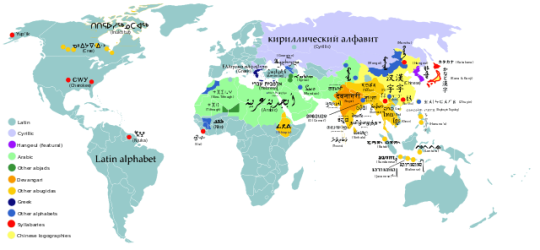
Segmental systems
A segmental script has graphemes which represent the phonemes (basic units of sound) of a language.
Alphabets
Alphabets, or phonemic alphabets, are sets of letters that represent consonants and vowels. The word “alphabet” is derived from alpha and beta, the first two symbols of the Greek alphabet.
Alphabets currently in use include Armenian, Cyrillic, Georgian (Mkhedruli), Greek, Korean (hangŭl), Latin/Roman, N’Ko, and Tifinagh.

Abjads
The first type of alphabet that was developed was the abjad. An abjad is an alphabetic writing system where there is one symbol per consonant. Abjads differ from other alphabets in that they have characters only for consonant sounds, although vocalization is used in specific contexts, such as in religious books and children’s books. The term “abjad” takes its name from the old order of the Arabic alphabet’s consonants 'alif, bā', jīm, and dāl.
Arabic, Hebrew, and Thaana are the only abjads currently in use, but Samaritan and Syriac are used to a limited extent.
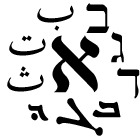
Abugidas
An abugida is an alphabetic writing system whose basic signs denote consonants with an inherent vowel and where consistent modifications of the basic sign indicate a different vowel than the inherent one. The graphic similarity of most abugidas comes from the fact that they are derived from abjads, so that consonants make up the symbols with the inherent vowel and new vowel symbols are markings added on to the base symbol. The name “abugida” is derived from the first four characters of an order of the Ge’ez script used in some contexts.
Abugidas that are currently in use include Bengali, Burmese, Cree (Nêhiyaw), Dehong Dai (Tai Le), Devanāgarī, Fraser, Ge’ez (Ethiopic), Gujarāti, Gurmukhi (Punjabi), Inuktitut, Kannada, Khmer, Lao, Malayalam, Naskapi (Innu Aimun), Ojibwe (Anishinaabe), Odia, Sinhala, Tamil, Telugu, Thai, and Tibetan.
The ones used to a limited extent are Balinese, Batak, Bilang-bilang, Blackfoot (Siksika), Buhid, Carrier (Dulkw’ahke), Chakma, Cham, Dhurwa, Ditema, Gondi, Grantha, Hanifi, Hanuno’o, Hmong, Javanese, Jenticha, Kaithi, Kerinci, Khoiki, Kirat Rai, Kulitan, Lampung, Lanna, Lepcha (Róng-Ríng), Limbu/Kirati, Lontara, Lota Ende, Manipuri (Meetei Mayek), Mon, Mwangwego, New Tai Lue, Ranjana, Rejang, Sasak, Satera Jontal, Saurashtra, Shan, Sharda, Siddham, Sorang Sompeng, Soyombo, Sundanese, Syloti Nagri, Tagalog, Tagbanwa, Tikamuli, Tolong Siki, Tigalari, and Varang Kshiti.

Syllabic systems
A syllabary is a set of written symbols that represent or approximate syllables, which make up words.
Syllabaries currently in use include Cherokee (Tsalagi), Hiragana (Japanese), Katakana (Japanese), and Yi (Nosu).
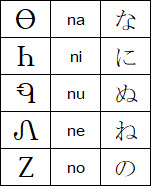
Logographic systems
The symbols used in logographic systems often represent both sound and meaning. These scripts can also be called semanto-phonetic, logophonetic, morphophonemic, or logosyllabic.
They may include the following types of symbol:
Pictograms and logograms
Pictograms or pictographs resemble the things they represent. Logograms are symbols that represent parts of words or whole words.

Ideograms
Ideograms or ideographs are symbols which graphically represent abstract ideas.

Compound characters
Compound characters include a semantic element, which represents or hints at their meaning, and a phonetic element, which shows or hints at their pronunciation.

The semanto-phonetic writing systems currently in use are Chinese (Zhōngwén) and Japanese (Nihongo), while Naxi is used mainly for decorative, ceremonial or religious purposes.
Directionality
Scripts are also graphically characterized by the direction in which they are written. Egyptian hieroglyphs were written either left to right or right to left.
The early alphabet could be written in multiple directions: horizontally (side to side), or vertically (up or down). Prior to standardization, alphabetic writing was done both left-to-right and right-to-left.
The Greek alphabet and its successors settled on a left-to-right pattern, from the top to the bottom of the page. Other scripts, such as Arabic and Hebrew, came to be written right-to-left. Scripts that incorporate Chinese characters have traditionally been written vertically (top-to-bottom), from the right to the left of the page, but nowadays are frequently written left-to-right, top-to-bottom, due to Western influence.
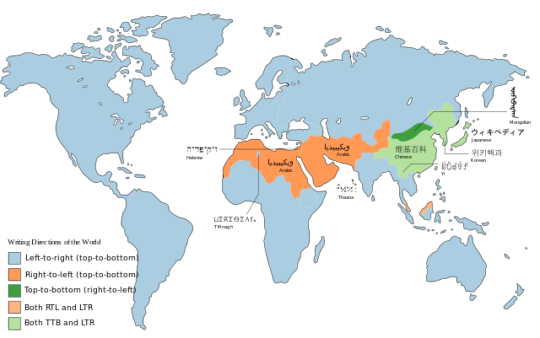
3K notes
·
View notes
Photo

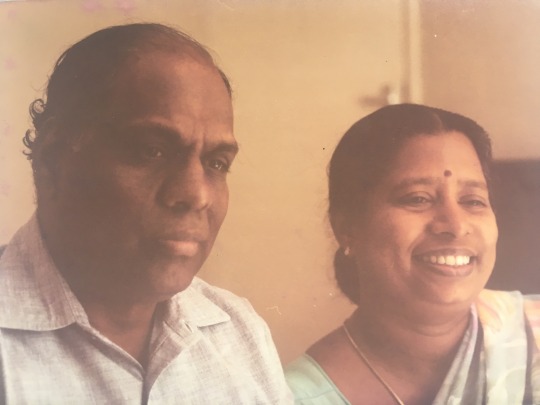
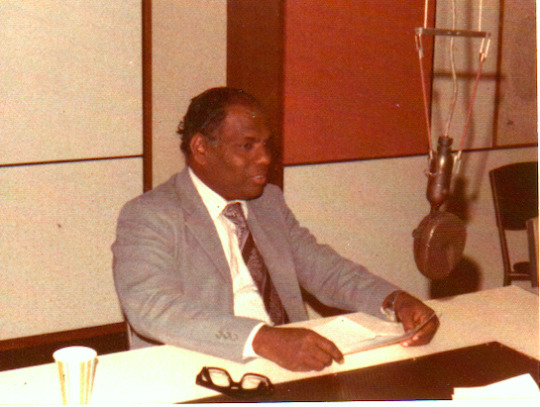

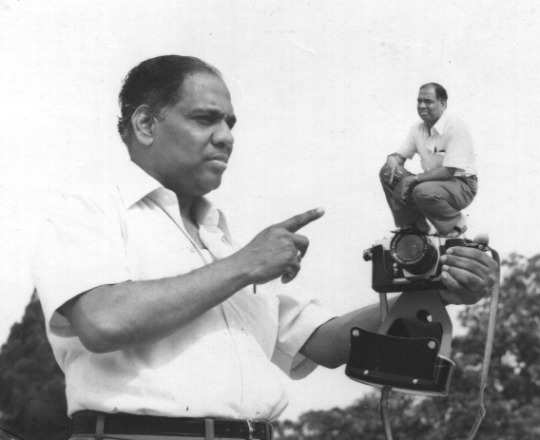
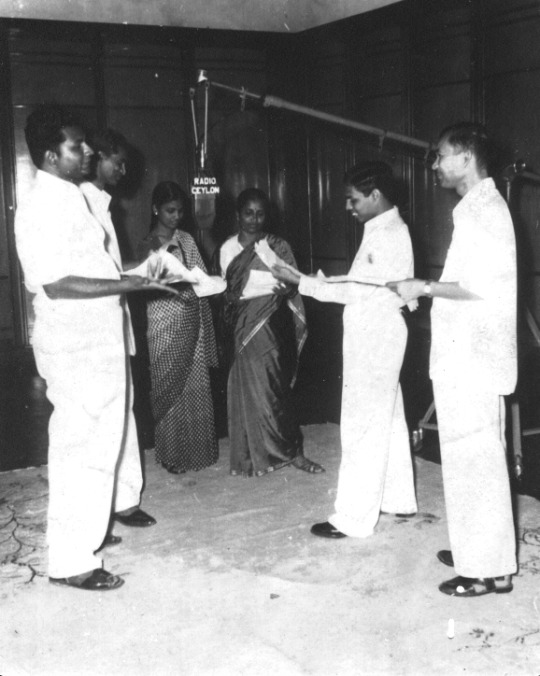
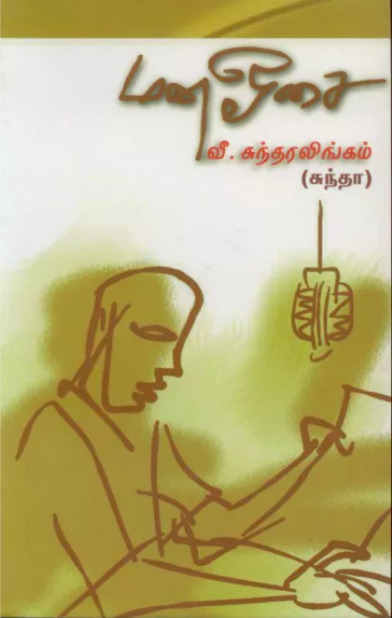

Photo 1: Parasakthy and Sundha 1961 in Colombo Photo 2: Parasakthy and Sundha in the 80s in Chennai Photo 3: Sundha as a BBC newsreader 1982 in London Photo 4: Sundha interviewing a young Mathematics prodigy from Tamil Nadu from Radio Ceylon studios 60s in Colombo Photo 5: Sundha was also a talented photographer, and this is one of the photos he took and cheekily edited on his film camera Photo 6: Sundha performing in one of the radio dramas, Radio Ceylon 1950s Photo 7&8: Front and back cover of ���Mana Osai - Reminiscences of a Broadcaster’ a book about Sundha Paraskathy Sydney, Australia *note that uncle refers to Parasakthy’s husband, the late Sundharalingam. In 1948, uncle, as a young boy, had listened to the running commentary of Mahatma Gandhi’s funeral procession. Back then in Jaffna nobody had a radio at home, so the school principal hired one for the kids to be able to listen to Gandhi’s tributes. Uncle said that he and many of the children cried. Uncle was so amazed at how something happening in a distant land could move people in his village in Chavakacheri. In his wonderment at how this was possible, his dream to one day become a radio announcer was born. Sri Lanka started broadcasting in 1923, three years after Europe started the BBC. The transmitter was built using equipment from a captured German submarine. Colombo Radio, later known as Radio Ceylon, started broadcasting in English first and later added Sinhhalese and Tamil . As the station’s popularity grew in India, Hindi was introduced, which also catered for the Hindi-speaking businessmen in Colombo. While uncle was studying at Jaffna Central college, he stayed in a hostel and would listen to the 9pm All India Radio news on the public radio installed in Subramanian Park while the other students would be engrossed in their studies. At the age of 21, uncle started working in Colombo, having skipped his university entrance exam to earn money. There he found himself working in the office next to Radio Ceylon. One of his colleagues was a radio drama artist and invited uncle to join him. Uncle fell in love with the stage and soon became popular for his theatrical talents. When a vacancy opened up for a news reader, he applied and was appointed to the job. By the fifties, radio had become a big craze in Jaffna, but very few people could afford a radio and our parents also didn’t want us to get distracted by listening to film songs and dramas. Even if we could afford a radio, my family didn’t have electricity. We had a simple life and education was our main focus. Uncle’s family also didn’t have electricity and had to go to a neighbour's house to listen to his broadcasts. While at Radio Ceylon, he was seconded for a ministerial post as press officer with the option of returning to his job as a news announcer when he wished to do so.
His duties included reading the papers and giving the minister a summary of daily events as well as interpreting speeches from Sinhala to English or Tamil. He also accompanied different Sinhalese ministers on their trips, bearing witness to their acts incitement of discrimination against the Tamils. He would often come home and tell me how sad he felt. His next job was as a simultaneous interpreter in parliament, a service provided for the Members of Parliament . Most of the Members spoke only Sinhalese or English and uncle worked as the Tamil translator.
Because parliament only sat for a few days a year, uncle had a lot of free time, which he filled by voicing jingles for advertising companies and performing in radio plays .
The stage was like a second home for him. He had so much confidence in all three languages. In 1969, he and another interpreter were selected to do the simultaneous interpreting for the Apollo 11 moon landing on July 20. These Sinhalese and Tamil interpretations, which were done non stop for three days, were broadcast by Radio Ceylon all around the country and region, capturing that awe-inspiring moment in history. The US Embassy in Colombo trained the team, which included Tamil and Sinhala scientists, for about a week, so that they were familiar with the technical terms. They also had to go through a simulated landing. Uncle found the American English difficult, but managed to successfully complete the task. Though Sinhala chauvinism escalated well before the eighties, we never imagined it would eventuate in the pogroms and violence that followed, culminating in the atrocities of 2009.
When the Sinhala Only Bill was passed in 56, uncle had to read it out as news on Radio Ceylon and had to cover stories of its implementation. Uncle was also a news reader during the 58 ethnic riots and the 76 and 78 pogroms.
Uncle's time at Radio Ceylon, his time in parliament and our years in India, the UK and Australia as a refugee during which time he yearned to return to our country of birth, had a profound effect on him. His resulting grief stayed with him right until his last days in Australia. In 1959, I graduated with a BA in Arts from Peradeniya University. My family never thought I would get a place in the university, as it was a difficult entrance exam. In those days, the results were announced in the English newspapers. But in our home, we only read Tamil newspapers. My father's friend saw the results and sent the paper to our home, with my name underlined, through another friend. I also had the option of entering a Teachers Training College to study teacher training, which required a less competitive mark than university studies. My school principal, the late Miss Thambiah, however encouraged me to enrol in university and promised me that I would have a job back at our school, Vembadi Girls’ High School, when I had finished my degree.
In Jaffna, education was mainly segregated into male and female schools. In certain schools, at the higher levels there was mixed education. So university was where I first met men, outside my immediate family. It was also the first time I met Sinhalese students. There were about fifty Tamil students and two or three hundred Sinhalese students. We enjoyed our single rooms and ate in a dining hall with fork and spoon. We were served a lot of beef and so I became a vegetarian. University is where I tasted cheese for the first time. Our education was free, and our living expenses were minimal. Those of us who remember the days of no ethnic divide, will remember university as a wonderful experience. Those days we had the best of everything in Sri Lanka - free education and free medical services. Everything was good, till the politicians of the majority community poisoned the minds of the people against the minorities living in the country. I think that now it's too late for change. The poison has sunk in too deep. After my studies, I returned to Jaffna and started teaching at my high school. I was so happy and I had many dreams of helping my siblings, who were excelling in their studies. But a marriage proposal to uncle came my way in 1961 and though I had a lot of ambitions and wasn’t keen on it, it was my parents wish and so I obliged. After our wedding, I joined uncle in Colombo where we had a comfortable life, like most middle class families. I got a job at the Muslim Ladies College in Bambalapitya Colombo. Teaching in a multicultural environment was another unforgettable experience. Our move to Chennai in 1980 was not my decision and nor was I in favour of it. Our only daughter Subhadra had just sat for her OL exam and was keen to continue her bharathanatyam studies, while we wanted her to attend university. It came as a rude shock when one morning in January 1980 uncle asked me to sign my retirement papers. He explained there was an option for lady teachers to retire after twenty years of service, which i had just completed, and I could avail myself of that facility. He said I could go to Chennai to educate Subhadra in the Fine Arts (music and dance), while at the same time help her to get a degree in Arts/Science. My school principal refused to endorse the papers as I was in the process of being appointed as principal of the newly built Colombo Hindu Ladies College. I was appalled! Who would throw away everything so good? I was in a dilemma but my husband solved it for me. He said “a decision has been made, let us not go back on it”. He said that Tamils couldn’t live in Sri Lanka in peace anymore and that political unrest was simmering. He said that he no longer wanted to live like a fugitive in his country of birth ‘his தாய் நாடு’ and that after translating the venomous speeches of the Sinhalese Members in parliament, he had spent many years of sleepless nights. He said that at least in Tamil Nadu we would feel a sense of familiarity and could continue to be part of the Tamil culture and language. He reminded me that we had to seek refuge in a Muslim friend’s house during the 1977 pogrom and that our daughter had no chance of entering university with the government’s standardisation policy which penalised Tamil students. So in Jan 1980 I retired and we left for Madras, our home for the next twenty years. There were only three other Tamil families from Sri Lanka who had settled down in Chennai after the first pogrom in 1958 and they all welcomed us graciously. Mr and Mrs Sivapathasundaram had made Adyar their home, the suburb which would become our home too. Mr Sivapathasundaram was a renowned broadcaster at Radio Ceylon and a popular Tamil writer on par with Indian writers. He was the one who gave the name Thamilosai to BBC Tamil Radio. We realised theirs was a life of struggle even after spending nearly three decades in Tamil Nadu. Our years in Chennai were also tough, and those who came to visit us were shocked to see how we were living in a single room annex. In 1982, we received a surprise phone call from the BBC asking uncle if he would come and work as the Tamil radio producer for one year, while Mr Shankaramoorthy, the then producer, took one year of medical leave. In uncle’s previous trips to the UK he had acted in some of the BCC Thamilosai’s radio dramas and so they were familiar with his talents. Subha had entered Stella Marie’s College, so we put her in the college hostel and set off on our year long UK adventure. We could have stayed on after our contract was over by taking part in radio programmes, however uncle said that he wanted to listen to carnatic music and hear Tamil in his ears - காதிலே தமிழும் பாட்டும் கேட்கவேணும் ! So after our stay in the UK was over, we flew straight to Colombo, with the hope of settling back there. After about 10 days of visiting our families in Jaffna, uncle, again said that he felt something bad was going to happen and he wanted to get back to Chennai. I again didn’t want to leave. I missed our family and they missed us. We had nobody in Chennai. Uncle however insisted that we had to return to see our daughter Subha and once again said “I don’t want to be a second class citizen in my own country”. We arrived back in Chennai in May 1983. In July when the pogrom against the Tamils started in Colombo, those who had money, got on planes and arrived at our doorstep. Over the following six months, at least a hundred Tamils made their way to our home straight from the airport. We helped them find temporary accommodation to begin with, then a home and a school for their children. We became local guardians to hundreds of children, as this was a government requirement. There were number of challenges we faced as guardians - illness - exam failures - two missing students - but we were thankful we could help them. Those who could afford to sent their children to other foreign countries. Thanks to the BBC, we had a telephone, which became so useful for the many Eelam Tamils who would line up outside and inside our home to use it. One night, we had more than 20 people sleep in our tiny annex. Those nights were tough, but what were we to do? Uncle, who looked to life’s positives, would often tell us that he was grateful that we got out in time and didn’t have to go through the trauma of watching our people being massacred. He was even more thankful that we were in a position to be able to help those that did escape. After hearing of the massacres and the burnings of the 83 pogrom, the people of Tamll Nadu became sympathetic to our cause and opened up their homes for rent. MGR, was the Chief Minister at the time, and said all Eelam Tamils could be accepted into schools in Tamil Nadu. For those who didn’t have money and escaped the island by boat, they were kept in refugee camps in Tamil Nadu, and their plight was and still is an incredibly sad one. Many are still there with very little protection or hope for a better future. We were the lucky few and though we never returned to live in our country, we have a lot to be thankful for. In the years that followed, uncle became BCC’s Thamilosai correspondent for Tamilnadu, which allowed us to continue living in the India and provided us with a permanent income. Thanks To BBC, we were also able to get a visa to visit our daughter in Australia. After uncle passed away in Australia after a tragic accident in 2001, I did not want to go back to India and all my family members had left Sri Lanka by then. I stayed on with my daughter's family as a refugee for 12 long years. It was a period of struggle and great uncertainty, thanks to the Australian government. I was finally granted Australian Citizenship in 2017. END In 1999 Dr Maunaguru, a close friend, turned audio recordings by uncle about his life into a book titled ‘Mana Osai -Reminiscences of a Broadcaster‘. Uncle was not keen on the book idea, but he agreed on one condition that the book when published would be distributed free - he said everyone has a story to tell so it's not fair to make money off it. Aunty’s grandson Senthan is now also a radio broadcaster and co-hosts the popular podcast Stuck in Between.
2 notes
·
View notes
Text
Free Online Sinhala Language to English Translation - Translate Sinhala Instantly
Unlocking the Secrets of Sinhala: A Gateway into Sri Lankan Culture In a world that is becoming increasingly interconnected, the ability to communicate across languages and cultures has never been more important. One language that holds immense significance in this regard is Sinhala, a tongue that is deeply intertwined with the vibrant tapestry of Sri Lankan culture. In this article, we will…

View On WordPress
#Cultural Translation#English translation#Language translation#LanguageXS#sinhala interpreting#sinhala language to english#sinhala to english translation#Sinhala Translation#Translation Services
0 notes
Text
INTERVIEW_10

K.T.A.MANJU MEDHA KASTHURIRATHNE
Countries & Regions /Sri Lanka
1. Job description
I am from Sri Lanka and joined FDK Lanka (Fujitsu local subsidiary) in Sri Lanka after graduating from a vocational school. At that time, I was assigned a job in the International Trade and Business Department. However, because of my expertise in OS software for computers, I wanted to utilize my knowledge in this field in Japan, which led me to start my own computer-related business company in Shizuoka Prefecture in 2007. At first, most of the work involved computer hardware, but gradually I received many requests to shoot and edit videos. I now create content for YouTube and produce programs for foreigners at the request of the Shizuoka Association for International Relations and Shizuoka University in Shizuoka Prefecture. I was also engaged in international exchange work sponsored by Shizuoka City and shot and edited news programs for foreigners for five years until 2018. People using online tools, such as YouTube, have increased due to the COVID-19 pandemic. For instance, I was in charge of filming and editing online theater screenings of Koizumi Yakumo's works during this period. My acquaintances often recommend my work, so thanks to them, I could work on video production, such as videos on screenings, hospital treatment, and teaching materials. The news is spreading by word of mouth, “If you ask Mr. Manju, he will do it.” I also run a café bar that serves Sri Lankan cuisine two or three evenings a week. It is called SPICE CAFE modhaju. I run it to create a place for people who want to visit Sri Lanka so that more people can get to know Sri Lankan cuisine. I also use my strengths as a Sri Lankan to help interpret for the Shizuoka Prefectural Police and medical care providers. I feel that there is a high demand in this field because few people can speak Sinhala, the native language of Sri Lanka.

2.Reason for relocating to Shizuoka Prefecture When I became a junior high school student, I became interested in Japanese. I took up a course held at the Japanese Embassy in Sri Lanka to learn Japanese. I became interested in Japanese because when considering to learn a language from scratch, Japanese was ideal as the grammar and pronunciation are similar to Sinhala, Sri Lanka's native language. I continued to study Japanese for six years, from high school to vocational school. I obtained Level 3 of the Japanese-Language Proficiency Test and improved my Japanese to the level where I placed 10th place in Sri Lanka. With this track record, I joined Fujitsu in Sri Lanka after graduating from a vocational school. I have felt a close connection to Shizuoka Prefecture since that time. Coincidentally, the teacher who taught Japanese was from Hamamatsu, and the boss of Fujitsu (FDK Lanka), a local subsidiary of the company, was also from Shizuoka Prefecture, so Shizuoka Prefecture became a familiar place to me. After I started working in Sri Lanka, I heard that a Japanese language school in Shizuoka Prefecture wanted to have a Sri Lankan international student, so I came to Shizuoka in 1997. Then, I studied at a Japanese language school for two years, got an N1, took the entrance examination for the University of Shizuoka, and started working in Shizuoka Prefecture after graduating. At that time, there were only two Sri Lankans in Shizuoka City, and I was the first Sri Lankan international student who came to Shizuoka City. I was also the first Sri Lankan to enter the University of Shizuoka. The number of Sri Lankans has now increased to about 400. Looking back on that time, I am thrilled that many people from my country live in Shizuoka City now and that we are gradually creating an environment where foreigners can easily work. I actually had the opportunity to leave Shizuoka Prefecture when I went on to university and also after I graduated from university. However, I decided to stay in Shizuoka Prefecture. The reason was I was attracted by the ease of working and living in Shizuoka Prefecture.

3.Attractive qualities of living in Shizuoka
As I mentioned earlier, I believe that one of the attractive qualities of Shizuoka Prefecture is the ease of working and living here. I believe that the ease of working here is due to the fact that I am a sole proprietor, and also, people in Shizuoka can easily form good relationships. One of the characteristics of the people of Shizuoka is that once you gain their trust, the relationship becomes stronger. This quality is very attractive to me personally because relationships are really important to me, as an acquaintance would often introduce work to me.
Although it is true that whether people feel that a place is comfortable depends on the individual, in my case, I feel calm and relaxed whenever I see the tea fields in Shizuoka. They are similar to the tea fields in my home country, Sri Lanka. The warm climate also suits me, and the warmth of the people here is similar to the atmosphere of Sri Lanka. It is difficult to describe in words, but there are many foreigners around me who think of Shizuoka Prefecture as their second home. Because of the ease of living in Shizuoka Prefecture, many of them are employed in Shizuoka Prefecture, as they have been there since they were students.
Although there are times I think Tokyo and Osaka have more business opportunities, I am happy to be living in Shizuoka Prefecture at a leisurely pace. I think that having good access, as it is easy to go to Tokyo and Osaka, while being comfortable living here, is also a benefit for those who are thinking about moving from the Tokyo metropolitan area and the Kansai area to Shizuoka. I am busy these days and I don't have holidays, but I have always loved taking photos. That being the case, I go to the sea to shoot and take pictures and think about how to promote the countryside. I like to take photos of the moon, so I am obsessed with taking pictures of the moon together with iconic Shizuoka symbols, such as Mt. Fuji. Regrettably, although I have tried many times, so far, I have not been able to take good photos of that particular scene. Some of my other favorite places are Miho no Matsubara, Tagonoura, and Yaizu. From these places, Mt. Fuji looks beautiful, and I enjoy taking photos of the sea and Mt. Fuji at these places. I think that being able to see Mt. Fuji and other beautiful views are quintessential qualities of Shizuoka Prefecture.

4. Message
I came to Shizuoka Prefecture as an international student. I have found Shizuoka Prefecture to be a very attractive place to study as an international student because there are many universities to choose from, and a wide range of options, such as automobile maintenance vocational schools.
The number of companies that want to employ foreigners, even after graduation, is also increasing and the environment in which foreigners can play an active role at work is being created. For instance, in Atami and Izu, many foreigners are actively involved in the tourism industry.
More than anything else, I would like to mention again that it is easy to live in Shizuoka. At present, we have people of various nationalities. Shizuoka provides an environment where foreigners are easily accepted. I personally don’t feel it is hard to live here. You can also make friends with various kinds of people at the international exchange festivals held by Shizuoka City. I often participate in such events when I want to meet old friends. I enjoy meeting everyone when I go to such places. I would be happy if my story could be of use to anyone in the future. I would be thrilled if I could help foreigners who are in a similar situation.

0 notes
Text
Parliament of Sri Lanka Vacancies 2022
Parliament of Sri Lanka Vacancies 2022
Parliament of Sri Lanka Vacancies 2022 – Parliamentary Interpreters, Computer Programmer, Technical Officer (Electrical) Government Job Vacancies in Sri Lanka in Parliament of Sri Lanka 01. Parliamentary Interpreter (Sinhala/English/Sinhala02. Parliamentary Interpreter (Sinhala/Tamil/Sinhala)03. Parliamentary Interpreter (English /Tamil/ English)04. Computer Programmer05. Technical Officer…
View On WordPress
#Computer Programmer#Government Job Vacancies 2022#Parliamentary Interpreters#Technical Officer (Electrical)
0 notes
Photo

Parliamentary Interpreter Vacancy – Parliament of Sri Lanka Closing Date: 2020-09-11 Parliamentary Interpreter - Parliament of Sri Lanka Sinhala Preview English Preview Download Sinhala Advertisement…
0 notes
Text
Astrology Chart Specific Date
Contents
Astrology love compatibility
Astrology. … compatibility charts
Free birth chart
Personal zodiac horoscope
German moon astrology
Health horoscope trying to define what health problems someone born on a specific date may confront through a subjective approach to the assigned zodiac sign and its characteristics.
The following is a chart showing the astrology love compatibility of zodiac signs. Take a look at the chart and see which zodiac signs are best together! To read the zodiac signs compatibility chart, simply find your zodiac sign in the left column and see the size of the heart located in the column that corresponds to your partner’s zodiac sign.
Birth Chart Calculator. This would mean that their natal charts showing planetary placements would be different from each other. So, to cast a birth chart, birthdate, time and place are all needed. You can calculate a birth chart for any location and for any date between 1900-2100, and get your free natal chart below.
To calculate your astrology birth chart, you’ll need your time, date and place of birth. Some people don’t know their birth time. If you can’t find it on your birth certificate, you can try contacting the Vital Records office in your state or area of birth.
Transit Chart Calculator, Astrology Transits online Free interpretation. … other planets online calculator – Seek and meet people born on the same date as you.
Free horoscopes and compatibility reports from Cafe astrology. … compatibility charts with ratings, horoscopes, and transits for any date in the past, present, and …
Cafe Astrology offers free astrology reports. … Birth chart …. For those interested in knowing the possible range of signs and degrees on a particular day, read on.
Astrology Moon Sign Pisces Moon Astrology Today Uk Displays phases of the Moon, lunar days and the mansions of the Moon, the Moon's position in the Zodiac (the Moon sign), apogees and perigees, void of … I am not a student of Chinese Astrology but I do know the new Moon in Aquarius, 4th here in the UK, is one
free birth chart Interpretation and Personal Astrology Reading Follow @freehoroastro Free Horoscopes Astrology has made special arrangements to bring you your free birth chart , a personal zodiac horoscope chart and astrology reading based on your birthday date, place and time …
Astrology App Pc Download Helakuru – Digital Sinhala Keyboard for PC free at BrowserCam. Learn how to download as well as Install Helakuru – Digital Sinhala Keyboard on PC (Windows) which is certainly produced by Bhasha Lanka (Pvt) Ltd. with useful features. Astrology Signs german moon astrology Today Uk Displays phases of the Moon, lunar days and the Astrology Colors Meaning Your zodiac (or Sun) sign is the biggest influence on your life and personality in Astrology! Based on the location of the expressive Sun at the minute you were born, you could be one of 12 zodiac signs, each with its own set of strengths, challenges, moods, patterns, relationships, and more. Zodiac Signs Compatibility Read

Chart data is saved in a cookie in your browser. If you clear your cache, the data stored will be erased. However, if you take note of the Profile number and PIN directly below your list of charts, you can log in to a profile with these numbers in order to retrieve the chart data.
0 notes
Text
The Dhammapada. Preface by Acharya Buddharakkhita.
The Dhammapada is the best known and most widely esteemed text in the Pali Tipitaka, the sacred scriptures of Theravada Buddhism. The work is included in the Khuddaka Nikaya ("Minor Collection") of the Sutta Pitaka, but its popularity has raised it far above the single niche it occupies in the scriptures to the ranks of a world religious classic. Composed in the ancient Pali language, this slim anthology of verses constitutes a perfect compendium of the Buddha's teaching, comprising between its covers all the essential principles elaborated at length in the forty-odd volumes of the Pali canon.
According to the Theravada Buddhist tradition, each verse in the Dhammapada was originally spoken by the Buddha in response to a particular episode. Accounts of these, along with exegesis of the verses, are preserved in the classic commentary to the work, compiled by the great scholiast Bhadantacariya Buddhaghosa in the fifth century C.E. on the basis or material going back to very ancient times. The contents of the verses, however, transcend the limited and particular circumstances of their origin, reaching out through the ages to various types of people in all the diverse situations of life. For the simple and unsophisticated the Dhammapada is a sympathetic counselor; for the intellectually overburdened its clear and direct teachings inspire humility and reflection; for the earnest seeker it is a perennial source of inspiration and practical instruction. Insights that flashed into the heart of the Buddha have crystallized into these luminous verses of pure wisdom. As profound expressions of practical spirituality, each verse is a guideline to right living. The Buddha unambiguously pointed out that whoever earnestly practices the teachings found in the Dhammapada will taste the bliss of emancipation.
Due to its immense importance, the Dhammapada has been translated into numerous languages. In English alone several translations are available, including editions by such noted scholars as Max Muller and Dr. S. Radhakrishnan. However, when presented from a non-Buddhist frame of reference, the teachings of the Buddha inevitably suffer some distortion. This, in fact, has already happened with our anthology: an unfortunate selection of renderings has sometimes suggested erroneous interpretations, while footnotes have tended to be judgmental.
The present translation was originally written in the late 1950's. Some years earlier, while consulting a number of English-language editions of the Dhammapada, it was observed that the renderings were either too free and inaccurate or too pedantic, and it was therefore felt that a new translation avoiding these two extremes would serve a valuable purpose. The finished result of that project, presented here, is a humble attempt by a practicing follower of the Buddha to transmit the spirit and content, as well as the language and style, of the original teachings.
In preparing this volume I have had access to numerous editions and translations of the Dhammapada into various languages, including Sanskrit, Hindi, Bengali, Sinhala, Burmese and Nepali. I particularly benefited from the excellent translations of the work by the late Venerable Narada Mahathera of Vajirarama, Colombo, Sri Lanka, and Professor Bhagwat of Poona, India; To them I acknowledge my debt. A few verses contain riddles, references or analogies that may not be evident to the reader. The meanings of these are provided either in parentheses or notes, and for their interpretation I have relied on the explanations given in Bhadantacariya Buddhaghosa's commentary. Verses discussed in the notes are indicated in the text by an asterisk at the end of the verse.
A first edition of this translation was published in 1959 and a second in 1966, both by the Maha Bodhi Society in Bangalore, India. For this third edition, the translation has undergone considerable revision. The newly added subtitle, "The Buddha's Path of Wisdom," is not literal, but is fully applicable on the ground that the verses of the Dhammapada all originate from the Buddha's wisdom and lead the one who follows them to a life guided by that same wisdom.
I am grateful to the editors of the Buddhist Publication Society for their helpful suggestions, and to the Society itself for so generously undertaking the publication of this work.
I make this offering of Dhamma in grateful memory of my teachers, parents and relatives, departed and living. May they find access in the Buddha's Dispensation and attain Nibbana!
May all beings be happy!
— Acharya Buddharakkhita
Source:
http://www.accesstoinsight.org/tipitaka/kn/dhp/dhp.intro.budd.html#preface
You may copy, reformat, reprint, republish, and redistribute this work in any medium whatsoever, provided that: (1) you only make such copies, etc. available free of charge and, in the case of reprinting, only in quantities of no more than 50 copies; (2) you clearly indicate that any derivatives of this work (including translations) are derived from this source document; and (3) you include the full text of this license in any copies or derivatives of this work. Otherwise, all rights reserved. Documents linked from this page may be subject to other restrictions. From The Dhammapada: The Buddha's Path of Wisdom, translated from the Pali by Acharya Buddharakkhita, with an Introduction by Bhikkhu Bodhi (Kandy: Buddhist Publication Society, 1985). Transcribed from the print edition in 1996 by a volunteer under the auspices of the DharmaNet Transcription Project, with the kind permission of the BPS. Last revised for Access to Insight on 30 November 2013.
11 notes
·
View notes